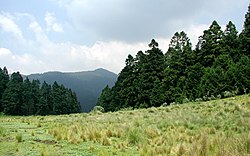| Habit | tree
| |
|---|---|---|
| Height: | ⇕ | 100 ft"ft" can not be assigned to a declared number type with value 100. |
| Width: | ⇔ | 20 ft"ft" can not be assigned to a declared number type with value 20. |
| Lifespan: | ⌛ | perennial |
| Exposure: | ☼ | sun |
|---|---|---|
| USDA Zones: | 8 to 10 |
|
Pinaceae > |
Abies > |
Sacred Fir (Abies religiosa, Oyamel in Nahuatl) is a fir native to the mountains of central and southern Mexico (Eje Volcánico Transversal, Sierra Madre del Sur) and western Guatemala. It grows at high altitudes of 2100 - 4100 m in cloud forest with high rainfall and cool, humid summers and dry winters in most of its habitat regime but in the state of Veracruz to the east it grows with precipitations all year long. Regular winter snowfalls occur on the highest populations.
It is a medium-sized to large evergreen coniferous tree growing to 25 - 50 m tall with a trunk diameter of up to 2 m ft . The leaves are needle-like, flattened, 1.5 - 3.5 cm long and 1.5 mm in wide by 0.5 mm in thick, dark green above, and with two blue-white bands of stomata below; the leaf apex is acute. The leaf arrangement is spiral on the shoot, but with each leaf variably twisted at the base so they lie flat to either side of and above the shoot, with none below the shoot. The shoots are reddish-brown, hairless or with scattered pubescense. The cones are 8 - 16 cm long and 4 - 6 cm broad, dark blue-purple before maturity; the scale bracts are purple or greenish, of moderate length, with the tips exposed in the closed cone. The winged seeds are released when the cones disintegrate at maturity about 7–9 months after pollination. Trees from the western end of the range on Nevado de Colima, Jalisco have cones with larger, reflexed bract scales (similar to Noble Fir cones); these are sometimes treated as a separate species, Abies colimensis.
Sacred Fir is named after the use of cut foliage in religious festivals in Mexico, notably at Christmas. The oyamel is the preferred tree for the Monarch Butterfly (Danaus plexippus) to reside in colonies during its hibernation in Mexico. The distribution of this tree is narrowing because of deforestation and human impact.
Cultivation
Propagation
Pests and diseases
Varieties
Gallery
References
External links
- w:Abies religiosa. Some of the material on this page may be from Wikipedia, under the Creative Commons license.
- Abies religiosa QR Code (Size 50, 100, 200, 500)
